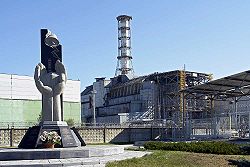
Comparison of Fukushima and Chernobyl nuclear accidents
Encyclopedia
The following table compares the nuclear accidents in Fukushima Daiichi (2011) and Chernobyl
(1986) nuclear plants.
Last update April 12, 2011 (reference from BBC News).
Chernobyl disaster
The Chernobyl disaster was a nuclear accident that occurred on 26 April 1986 at the Chernobyl Nuclear Power Plant in Ukraine , which was under the direct jurisdiction of the central authorities in Moscow...
(1986) nuclear plants.
| Fukushima Daiichi | Chernobyl Chernobyl Nuclear Power Plant The Chernobyl Nuclear Power Plant or Chornobyl Nuclear Power Plant is a decommissioned nuclear power station near the city of Pripyat, Ukraine, northwest of the city of Chernobyl, from the Ukraine–Belarus border, and about north of Kiev. Reactor 4 was the site of the Chernobyl disaster in...  |
|
|---|---|---|
| Location | Japan Japan Japan is an island nation in East Asia. Located in the Pacific Ocean, it lies to the east of the Sea of Japan, China, North Korea, South Korea and Russia, stretching from the Sea of Okhotsk in the north to the East China Sea and Taiwan in the south... |
Ukraine Ukraine Ukraine is a country in Eastern Europe. It has an area of 603,628 km², making it the second largest contiguous country on the European continent, after Russia... (ex. Soviet Union Soviet Union The Soviet Union , officially the Union of Soviet Socialist Republics , was a constitutionally socialist state that existed in Eurasia between 1922 and 1991.... ) |
| Date of the accident | March 11, 2011 | April 26, 1986 |
| Plant commissioning date | 1971 | 1977 |
| Years of operation before the accident | 40 years | 9 years |
| Electrical output | 4.7 Gigawatts | 1 Gigawatt |
| Type of reactor | Boiling water Boiling water reactor The boiling water reactor is a type of light water nuclear reactor used for the generation of electrical power. It is the second most common type of electricity-generating nuclear reactor after the pressurized water reactor , also a type of light water nuclear reactor... with containment vessel |
Graphite moderated without containment |
| Number of reactors | 6 — 4 (and spent-fuel pools) involved in accident | 4 — 1 involved in accident |
| Amount of nuclear fuel in reactors | 1,600 tons | 180 tons |
| Cause of the accident | Shut down of cooling system due to tsunami Tsunami A tsunami is a series of water waves caused by the displacement of a large volume of a body of water, typically an ocean or a large lake... |
Accidental failure during safety feature experiment |
| Maximum level of radiation Radiation In physics, radiation is a process in which energetic particles or energetic waves travel through a medium or space. There are two distinct types of radiation; ionizing and non-ionizing... detected |
800 mSv | 200,000 mSv |
| Radiation released | 370 PBq (as of 12 April 2011) | 5,200 PBq |
| Area affected | Radiation levels exceeding annual limits seen over 60 kilometres (37.3 mi) to northwest and 40 kilometres (24.9 mi) to south-southwest, according to officials. | An area up to 500 kilometres (310.7 mi) away contaminated, according to the United Nations. |
| Exclusion Zone Exclusion zone An exclusion zone is an area that protesters are legally prohibited from protesting in.Exclusion zones often exist around seats of government and abortion clinics. As a result of protests by the Westboro Baptist Church at the funerals of soldiers killed in the Iraq War, 29 states and the US... Area |
20 km (30 km voluntary) | 30 km |
| Population relocated | 300,000 | About 115,000 from areas surrounding the reactor in 1986; about 220,000 people from Belarus Belarus Belarus , officially the Republic of Belarus, is a landlocked country in Eastern Europe, bordered clockwise by Russia to the northeast, Ukraine to the south, Poland to the west, and Lithuania and Latvia to the northwest. Its capital is Minsk; other major cities include Brest, Grodno , Gomel ,... , the Russian Federation and Ukraine Ukraine Ukraine is a country in Eastern Europe. It has an area of 603,628 km², making it the second largest contiguous country on the European continent, after Russia... after 1986 |
| Direct casualties from the accident | none | 31 (64 confirmed deaths from radiation as of 2008, according to the UN) |
| Current status | Restoration of coolant to reactors and spent-fuel pools in progress. Radiation leaks continue and could eventually exceed radiation released at Chernobyl, according to officials. | All reactors were shut down by 2000. The damaged reactor is encased in concrete. A New Safe Confinement New Safe Confinement The New Safe Confinement is the structure intended to contain the nuclear reactor at Chernobyl, Ukraine, part of which was destroyed by the Chernobyl disaster in 1986. The idea is to prevent the reactor wreck from leaking radioactive material into the environment... structure is expected to be completed in 2013. |
Last update April 12, 2011 (reference from BBC News).

